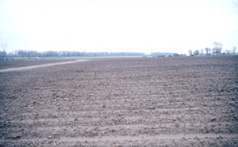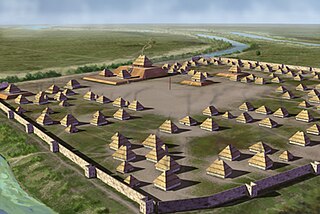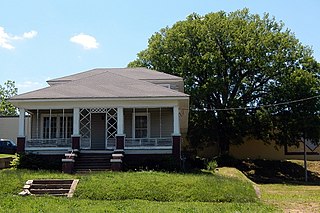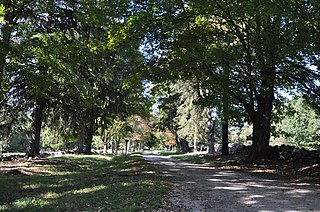
The Gladstone Pottery Museum is a working museum of a medium-sized coal-fired pottery, typical of those once common in the North Staffordshire area of England from the time of the industrial revolution in the 18th century to the mid 20th century. It is a grade II* listed building.

The Nodena Site is an archeological site east of Wilson, Arkansas and northeast of Reverie, Tennessee in Mississippi County, Arkansas, United States. Around 1400–1650 CE an aboriginal palisaded village existed in the Nodena area on a meander bend of the Mississippi River. The Nodena site was discovered and first documented by Dr. James K. Hampson, archaeologist and owner of the plantation on which the Nodena site is located. Artifacts from this site are on display in the Hampson Museum State Park in Wilson, Arkansas. The Nodena Site is the type site for the Nodena Phase, believed by many archaeologists to be the province of Pacaha visited by Spanish explorer Hernando de Soto in 1542.

The Eaker Site (3MS105) is an archaeological site on Eaker Air Force Base near Blytheville, Arkansas that was declared a National Historic Landmark in 1996. The site is the largest and most intact Late Mississippian Nodena Phase village site within the Central Mississippi Valley, with archaeological evidence indicating a palisaded village some 50 acres (20 ha) in size, with hundreds of structures. The site's major period of occupation was 1350–1450 CE, although evidence of occupation dates back to 600 CE. The site is also hypothesized to have been occupied by the Quapaw prior to a migration further south, after which they made contact with Europeans in the late 17th century.

Parkin Archeological State Park, also known as Parkin Indian Mound, is an archeological site and state park in Parkin, Cross County, Arkansas. Around 1350–1650 CE an aboriginal palisaded village existed at the site, at the confluence of the St. Francis and Tyronza rivers. Artifacts from this site are on display at the site museum. The Parkin Site is the type site for the Parkin phase, an expression of the Mississippian culture from the Late Mississippian period. Many archeologists believe it to be part of the province of Casqui, documented as visited by Spanish explorer Hernando de Soto in 1542. Archeological artifacts from the village of the Parkin people are dated to 1400–1650 CE.

This is a list of the National Register of Historic Places listings in Westmoreland County, Virginia.

This is a list of the National Register of Historic Places listings in Dallas County, Arkansas.

East Liverpool Pottery operated in East Liverpool, Ohio from its construction in 1844 until it ceased production in 1939. The site was made up of five buildings and 2 kilns. The company's bottle kilns, their shape resembling a bottle, were used for the production of pottery ware.

The Milwaukee Falls Lime Company is the former owner of a limestone quarry and lime kilns located in Grafton, Wisconsin. It was added to the National Register of Historic Places in 2012. The quarry and kilns are now Lime Kiln Park, which also features a pavilion, playground, walking paths, sledding hill, horseshoe pits, and disc golf course.

The Charles "Bullet" Dean Hyten House is a historic house at 211 South Main Street in Benton, Arkansas. It is a single-story Bungalow-style structure, with a hip roof that extends over its front porch. The porch is supported by square columns set on brick piers, with decorative metal latticework between the columns. Built in 1922, the house significant as the only surviving house associated with Charles Hyten and Niloak pottery. Hyten and Arthur Dovey together created a pottery process in 1909 that achieved swirling of different colors and types of clay, yet held together without shattering when baked in a kiln. The process was patented by Hyten in 1928. It was the basis of the Arts and crafts movement-era Niloak's Art pottery line.

Morgan Jones 1677 Pottery Kiln is a historic archaeological site located near Glebe Harbor and Hague, Westmoreland County, Virginia. The site was excavated in 1973, by staff from the Virginia Department of Historic Resources. It includes the remains of a pottery kiln operated by Morgan Jones and Dennis White in 1677. The site has kiln remains and many fragmentary samples of the pottery manufactured there.

The Pottersville District encompasses the earliest non-Native settlement in Harrisville, New Hampshire, as well as sites of some of the town's earliest industrial activities. The 93-acre (38 ha) district includes forty buildings and two archaeological sites, and was listed on the National Register of Historic Places in 1986.
The Bird Kiln is a historic pottery site in rural Dallas County, Arkansas. It is located off Arkansas Highway 9, about 6 miles (9.7 km) southwest of Leola. It is the site of a kiln which was set up in 1843 by William Bird, who established pottery as an industry in the area. Bird operated on the site until 1851, when he moved to another site north of Tulip. He and his brothers produced utilitarian salt glazed goods, and trained a whole generation of potters.
The Wommack Kiln is a history pottery site in central rural Dallas County, Arkansas. Built in 1891 by John Welch, it is the best-preserved of a series of pottery works established in Dallas County in the later decades of the 19th century. Welch established this site after abandoning an earlier site he set up in the 1880s.
The Welch Pottery Works of Dallas County, Arkansas, were active from c. 1851 to c. 1891. The pottery works, consisting of a kiln, sawmill, and other facilities, was established by the Bird brothers, who had been operating another kiln near Tulip since 1843.

The Louis St. Gaudens House and Studio is a historic house at Dingleton Hill and Whitten Roads in Cornish, New Hampshire. The 2+1⁄2-story gambrel-roofed wood-frame structure was designed by Moses Johnson and built in 1793–94 at the Shaker village in Enfield, New Hampshire. At that site the building served as the main meeting space for the Shakers, with a main meeting space on the ground floor, offices on the second floor, and guest living quarters in the attic space. The building is similar in construction to buildings designed by Johnson for the Shaker villages in Canterbury, New Hampshire and Sabbathday Lake, Maine.
William Dennis Pottery Kiln and House Site is a historic archaeological site located at Randleman, Randolph County, North Carolina. It was the site of the pottery kiln and home of William Dennis and his son Thomas and remained in operation until 1832. The pottery produced simple, utilitarian redware, and a variety of decorative slipware and tableware products. The William Dennis pottery and house site was located in 1974.
The Mount Shepherd Pottery Site is a historic archaeological site on the grounds of the Mount Shepherd Retreat Center, outside Asheboro, North Carolina. The site is that of a late 18th-century pottery, possibly of Moravian origin. The principal feature of the site is a five-flued circular kiln, and it was accompanied by numerous pottery fragments and items, including stove tiles, slipware, earthenware, and smoking pipes. The site has been associated with a Moravian master potter, Gottfried Aust, who one researcher believes ran the site between 1793 and 1799.

The Hervey Brooks Pottery Shop and Kiln Site is a historic industrial archaeological site in Goshen, Connecticut. It is the site of the 19th-century pottery of Hervey Brooks, a local potter significant for his extensive recordkeeping. Brooks' pottery included a shop and a stone kiln. The shop structure was moved to Old Sturbridge Village in the 20th century, where a reconstruction of his kiln has also been undertaken. The original site is of archaeological significance for identifying the materials Brooks used and how he laid out his work site, and for identifying how those changed over time.
Tulip is an unincorporated community in Dallas County, Arkansas, United States. The community is on Arkansas Highway 9 5.7 miles (9.2 km) west of Carthage.
Hiwassee Island, also known as Jollys Island and Benham Island, is located in Meigs County, Tennessee, at the confluence of the Tennessee and Hiwassee Rivers. It is about 35 mi (56 km) northeast of Chattanooga. The island was the second largest land mass on the Tennessee River at 781 acres before the Tennessee Valley Authority created the Chickamauga Lake as a part of the dam system on the Tennessee River in 1940. Much of the island is now submerged, leaving 400 acres above the waterline.














